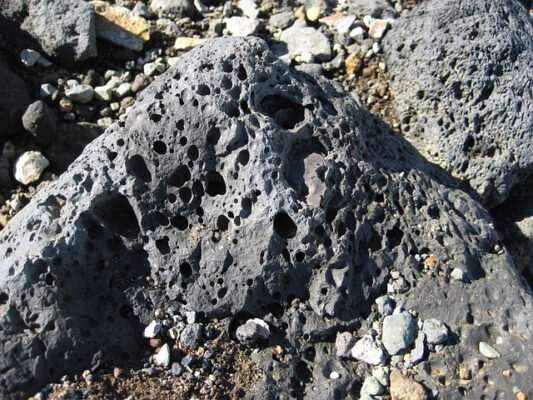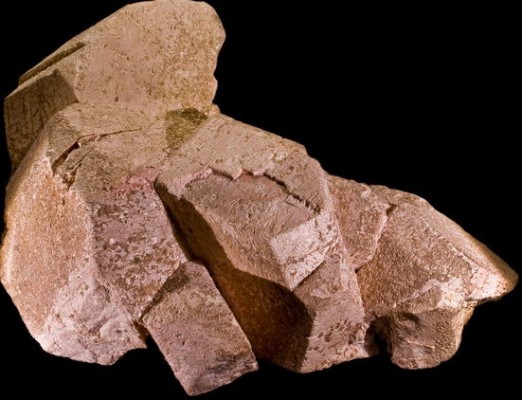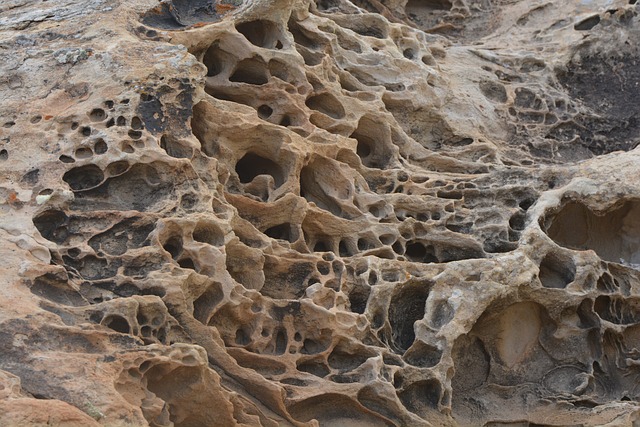Igneous rocks for kids brings some of the interesting and basic facts about these rocks. The interior of the earth is extremely hot. The overlying layers of rocks exert a lot of pressure upon the rocks lying underneath them which is why most of the earth’s interior exists in solid form. At the same time, there are few zones where pressure is low enough and temperature is quite high causing the rocks to melt and become molten material. This molten matter is known as ‘melt’. There are only two zones where rocks exist in liquid forms i.e. asthenosphere and outer core. When melt remains inside the earth’s interior, it becomes magma. This magma may also take several forms such as when it makes a way into fractures of solid rocks and stretches to the ground, it turns itself into lava. Thus, lava is a form of magma that reaches the earth’s surface. Likewise, at times it may also fly away at great distances as debris like ash and pumice and are thus known as pyroclastic materials. Magma may crystallize under the surface of the earth or lava goes hard above the ground (as lava), either way it gives rise to igneous rocks.
Igneous rocks are the first of all the three kinds of rocks. The other two are sedimentary rocks and metamorphic rocks. Now let’s dive deep into these rocks in igneous rocks for kids!
Names of common igneous rocks:
Granite
Basalt
Igneous Rocks for Kids – Classification of Igneous Rocks:
Igneous rocks are classified into two types:
- Intrusive igneous rocks
- Extrusive igneous rocks
They may also be classified into three types according to chemical composition:
- Mafic rocks
- Felsic rocks
- Intermediate rocks
Igneous Rocks for Kids – Processes of Igneous Rocks
Intrusive Igneous Rocks
- These rocks are formed when magma fails to reach the surface and it solidifies deep inside the earth forming intrusive igneous rocks.
- Because of the fact that interior of the earth is very hot, magma doesn’t solidify too quickly and develops into large crystals as a result. At times, it takes about hundreds of years for magma to solidify.
- These rocks are coarse-grained i.e. the grains are larger than 1 mm in size.
- Such rocks are also called plutonic rocks and their mineral crystals are easily noticeable.
- Granite is the most common and easily available intrusive igneous rock.
- Some rocks (like pegmatite) have very large crystals and the size of their grains ranges up to more than 5 cm.
 Fun Fact about Igneous Rocks
Fun Fact about Igneous Rocks
The images of the four US Presidents in South Dakota (Mount Rushmore) were carved out of intrusive igneous rock called Harney Peak Granite. This rock is about 1.7 billion years old. The same is true for Crazy Horse Memorial located close at hand.
Examples
- Gabbro
- Granite
- Diorite
Examples of locations where intrusive rocks are found
- Stone Mountain (DeKalb County in Georgia)
- Black Hills of South Dakota
- Mount Washington
Extrusive Igneous Rocks
- When magma rises to the earth’s surface and goes hard, it is known as lava and brings about extrusive igneous rocks.
- Since lava solidifies very quickly, it results in forming very fine-grained crystals which are barely visible. The word ‘fine-grained’ refers to the size of grains and it means grains are less than 1 mm in size.
- Such rocks are also known as volcanic rocks and their mineral crystals are not visible.
- The reddish-yellow lava may develop into volcanic rock (which is gray-colored material) within minutes or at times within few hours.
- The dark solid volcanic rock located at the floor of oceans is the most common extrusive rock known as basalt. It can be a very important building material.
 Examples
Examples
- Basalt
- Andesite
- Rhyolite
Examples of Locations where extrusive rocks are found
- The hills of Andes Mountains and Cascade Range
- Aleutian Islands in Alaska
- Hawaiian chain
Igneous Rocks for Kids – Identification of Igneous Rocks
The identification of igneous rocks is based on two things namely:
- Texture of rocks
- Chemical composition of rocks
The word ’texture’ basically means the composition, size and shape of grains that are combined to form igneous rocks. The size of grains is perhaps the most common way to recognize these rocks.
Unlike extrusive igneous rocks, intrusive rocks are fine-grained and so it is comparatively tricky to recognize them.
Relationship of Volcanic and Plutonic Rocks
Chemically, volcanic and plutonic rocks are related to each other. The chemical composition of a volcanic rock is exactly similar to its equivalent plutonic rock i.e. in terms of chemical composition, every volcanic rock has its identical twin rock in plutonic family of rocks. At the same time, the physical properties of these two adjacent rocks are nothing like each other.
Examples
According to chemical composition, the following rocks are related to each other:
Granite (plutonic) with Rhyolite (volcanic)
Gabbro (plutonic) with Basalt (volcanic)
Igneous Rocks for Kids – Composition of Igneous Rocks
- The mineral crystals inside these rocks are held very strongly together. Majority of igneous rocks are formed by joining together crystals like feldspar and quartz which is why these rocks are crystalline in nature.
- The most common mineral in rocks is Quartz. Chemically, it is known as silicon dioxide (SiO2).
- The earth’s crust is almost entirely composed of igneous rocks i.e. 95 percent.
- The earth’s mantle is made up of igneous rocks.
- Majority of igneous rocks are made up of atoms like silicon and oxygen. The compounds that contain these two atoms are known as silicate minerals. Silicate minerals break up into two classes as soon as magma hardens i.e. dark silicates and light silicates.
Dark Silicates
- These are also known as ferromagnesian silicates.
- Iron and magnesium are present in large quantities. The quantity of silica SiO2 is low however.
- Igneous rocks that contain high amount of dark silicates are known as mafic. It receives its name from two words; magnesium and ferrum (iron). These rocks have ‘basaltic composition’.
Examples
Olivine
Biotite mica
Light Silicates
- These are also known as nonferromagnesian silicates.
- Calcium, potassium and sodium are present in large quantities. The quantity of silica SiO2 is high as compare to dark silicates.
- Igneous rocks that have greater quantity of light silicates (like feldspars) are known as felsic because of ‘granitic composition’. The term ‘felsic’ comes from integrating two words; feldspars and silica.
- About 40 percent of igneous rocks are composed of feldspars.

Examples
Quartz
Feldspars
Magma
Magma is a very hot molten material that erupts from the outer core of the earth. It is by far the biggest pool of magma in the entire solar system.
There are two essential conditions for magma to blow up:
- Low pressure
- High temperature
Despite the fact that inner core is the hottest point under the earth’s surface, it cannot turn into magma because the pressure is too high. As a result, bonds cannot get away from each other and are in fact tightly held together forming solid rocks.
Magma rises upward because as it turns into a liquid, its density decreases as compare to the surrounding rocks. The surrounding rocks are known as country rocks. The atoms in country rocks are bonded tightly. But these atoms break free as soon as it turns into magma and they move randomly in all directions.
The chemical composition of magma is no different than the chemicals found in the earth’s crust i.e. silicon and oxygen. As high temperature softens rocks found in the earth’s mantle and turns it into magma, this hot liquid is rich in Magnesium (Mg) and Iron (Fe). This magma is therefore called mafic i.e. from magnesium and ferric (iron). At the same time, magma which is formed from continental crust is rich in potassium, sodium, aluminum and water. With a large amount of feldspars in it, this magma is known as felsic.
In terms of chemical composition, magmas (as well as igneous rocks) are divided into three kinds:
Mafic – where content of silica (SiO2) is less than 52 percent
Felsic – where content of silica (SiO2) is greater than 65 percent
Intermediate – where content of silica (SiO2) is found somewhere between 53 percent and 65 percent
The temperature of a hot lava ranges somewhere between 1000oC and 1200oC. From this, we can assume that magmas are much hotter. The basic reason why lavas can hang on to such huge temperatures for years is that the rock is a poor conductor of heat.
There are some magmas that can flow readily while others cannot. It is because fluids experience different kinds of resistance on their path. This resistance which determines the speed of magmas is known as viscosity levels. The higher the viscosity level of magma, the lower its speed would be and vice versa.
Magma of granitic composition has high viscosity level
Magma of basaltic composition has low viscosity level
Following are the main factors that determine the viscosity of magma:
- Temperature (cooler magma may not move as readily as hotter one)
- Concentration of silica (in silica, the silicon and oxygen atoms are strongly bonded together and thus slow down the speed of magma)
Conclusively, the magma which has low content of silica and hotter temperature moves quickly and smoothly. This way, felsic magma is not that much flowing as mafic magma in that it is rich in silica and cooler in temperature (means higher viscosity) than the latter one.
Examples of mafic and felsic lava
In 1783, mafic lava flowed in Iceland for 80 km before solidifying
In 1915, felsic lava flowed in California (Lassen Peak) for only 300 m
Did you really find these igneous rocks for kids good enough? Is it what you’re looking for? Please comment and help us improving this article. Thanks for reading it!


Leave a Reply